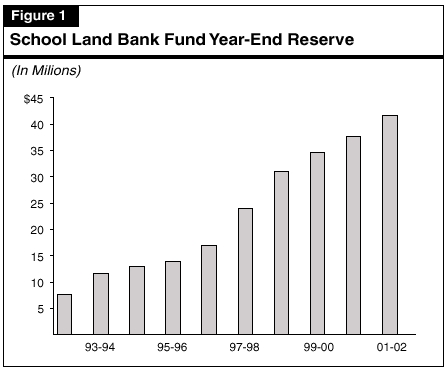Legislative Analyst's OfficeAnalysis of the 2001-02 Budget Bill |
The State Lands Commission (SLC) is responsible for managing lands that the state has received from the federal government. These lands total more than four million acres and include tide and submerged lands, swamp and overflow lands, the beds of navigable waterways, and vacant state school lands.
For 2001-02, the budget proposes $29.5 million for the support of the commission. The amount is funded from the General Fund ($20.1 million), the Oil Spill Prevention and Administration Fund ($5.8 million), the Exotic Species Control Fund ($1 million), and reimbursements ($2.7 million). The proposed budget is $7.5 million, or 34 percent, above the commission's estimated current-year expenditures. Most of this increase is to fund the removal and mitigation of hazards along the Santa Barbara and Ventura Coast, and in the Sacramento River.
The School Land Bank Fund (SLBF) is projected to have a reserve of $42 million by the end of the budget year. Because the State Lands Commission has expended almost no money from the fund since its creation in 1984, we recommend that the fund balance be transferred to the State Teachers' Retirement Fund, the original intended beneficiary of SLBF investments.
The SLC manages lands that were given to the state by the federal government in order to help support public education. Some of these school lands are leased for commercial purposes (such as mining and oil drilling). Lease revenues (royalties) are deposited in the State Teachers' Retirement Fund (STRF) after SLC recovers its costs.
Under the School Land Bank Act of 1984, the commission may also sell school lands and use the proceeds to purchase other properties in order to consolidate school land parcels into continuous holdings. The purpose of consolidating school lands is to facilitate the effective management of those lands for the purpose of generating lease revenue for STRF. Proceeds from land sales are deposited in the School Land Bank Fund (SLBF). These proceeds are available to SLC only for acquiring and enhancing school lands.
Imbalance of Sales and Purchases Has Caused Fund to Grow. Pursuant to the School Land Bank Act, SLC has sold school lands and deposited the proceeds in SLBF. However, because SLC has not expended SLBF monies to acquire new land holdings, the fund balance has mounted over the years.
Fund Balance Was an Issue at 1996 Legislative Hearings. During budget hearings in 1996, the Legislature examined the issue of the mounting reserve in SLBF. The balance was about $15.6 million at the time. The reserve had accumulated because SLC had not made any purchases from the fund since its creation in 1984. Noting this, we recommended that the Legislature reevaluate the purpose of SLBF. (Please see our Analysis of the 1996-97 Budget Bill, pages B-56 through B-58.) In the end, the Legislature decided not to change the fund's statutory purpose, in part because of SLC's assurance that it expected to use the fund to purchase property in the near future.
Budget Projects $42 Million Reserve for 2001-02. Since 1996, land sales have added another $15.8 million to the fund, while the fund has earned an additional $5.2 million in interest. However, at the time this analysis was prepared, SLC still had expended almost no money from SLBF for new investments. (The SLC has expended less than $100,000 from the fund for its operating costs.) As shown in Figure 1 (see next page), the fund is expected to have a reserve of $42 million at the end of 2001-02. This is almost triple the fund balance when the Legislature last examined the issue in 1996.
Legislative Intent Not Fulfilled. In enacting the School Land Bank Act in 1984, the Legislature expressed concern over a "significant depletion" of school lands, and stated its intent that all remaining school lands be "managed and enhanced" as a revenue-generating resource for STRF. The legislative goal of the program was to ensure that revenues from the sale of school lands would be reinvested in other land holdings that generate lease revenues for STRF. Maintaining a large fund balance for multiple years, however, does not achieve that goal.
Fund Balance Should Be Transferred to STRF. In view of SLC's inaction in purchasing new school lands with SLBF monies, as well as the significant reserve that continues to accumulate in the fund, we believe the Legislature should take action to ensure that its intent is fulfilled.

Specifically, we recommend that the balance of SLBF be transferred to STRF. In this way, the ultimate beneficiary of school lands proceeds—the State Teachers' Retirement System (STRS)—could invest those funds directly for the benefit of teachers.
We note that STRS has a significant portfolio and the staff expertise and organizational structure for identifying investment opportunities and managing the investments more efficiently than SLC. We also note that, under this recommendation, SLC would continue to manage existing school lands, and lease revenues from those lands would continue to be deposited in STRF.